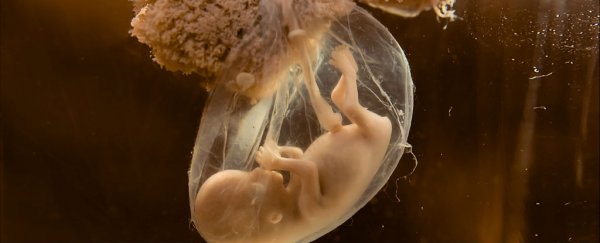We all know the story - egg meets sperm, gets fertilised, becomes a zygote. Once the cells start dividing, they clump and regroup, until at some point they start morphing into organs and body parts. Finally, that little blob of cells turns into a fully shaped miniature mammal, or bug, or frog.
But how do the cells know whether to create a bit of skin here, or a finger there, or grow into a tiny kidney at just the right spot? Basically, a cell needs instructions which will determine its fate - namely, which structure in the body the cell becomes involved in. Once that is determined, the cells go on to differentiate into nerve cells, skin cells, and so on. However, the nature of these instructions is not all that straightforward.
Cell determination occurs thanks to molecular signals between the cells, but it can also occur due to the distribution of certain molecules within a cell before it splits. These molecules are usually proteins or bits of RNA, which go on to influence the genes expressed in each cell.
For example, if a mother cell - one that's about to split into two daughter cells - has a lot of determinant 'nerve cell' molecules scattered on the left, after splitting, only the left-hand daughter cell will go on to become a nerve cell, because it carries these necessary determinants.
However, most of the time, cells in the minuscule embryonic proto-being actually determine each other's fate through something called inductive signalling. What happens here is that cells bust out certain proteins on their surfaces, which in turn inform neighbouring cells on what they need to become. This can happen through direct contact, or signals can also be sent through the empty space between cells.
When it comes to forming specific patterns to develop into certain parts of the body, the chemical signalling becomes even more complex. Cells release various amounts of signalling substances called 'morphogens'. These create a 'diffuse gradient landscape' where the concentration levels of a chemical in the tissue signal to the cells where they are located in relation to others. This in turn informs the genes in the cell's nucleus to switch on an off, determining what that cell group is growing into - a fingernail or a kidney.
What's fascinating is that all this knowledge is actually fairly recent - scientists have been trying to crack the cell determination problem since early 20th century, but the first gene that sends these types of chemical signals was only identified by embryologist Eddy De Robertis in 1990, in a frog embryo.
Scientists still don't know everything about this intricate chemical communication, but they are making progress. "In the past two decades, De Robertis and other researchers have unveiled a network of organizer genes that together produce a cocktail of signalling proteins which diffuse across an embryo in varying concentrations," writes Alex Riley in Nautilus magazine.
In light of this knowledge, it's no wonder that sometimes humans get developmental abnormalities - after all, the molecular and genetic communication system that shapes us all into functioning bodies is incredibly and beautifully complicated.
